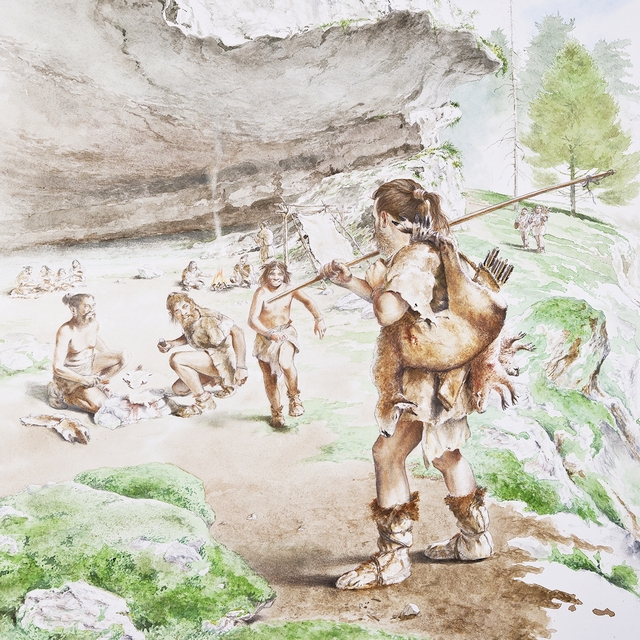A 13,000-year-old milk tooth tells us the movements of hunter-gatherers in northern Italy

(Foto: BONES Lab - Università di Bologna; credit: Soprintendenza archeologia, belle arti e paesaggio del Friuli Venezia-Giulia)
About 13,000 years ago, in one of the shelters of the Pradis Caves in the Friulian Pre-Alps, Italy, a child of 11 or 12 years old lost a baby tooth. Thanks to that small tooth, we now know that the group of hunter-gatherers to which the child belonged moved seasonally in that area with a specific purpose: hunting marmots. The discovery - published in Scientific Reports, a journal of the Nature group - comes from a research team led by scholars from the University of Bologna.
"This is the first direct evidence of the seasonal mobility strategies of human groups present in Northern Italy during the phase of the Epigravettian culture, in the late Upper Palaeolithic," explains Matteo Romandini, a researcher at the Department of Cultural Heritage of the University of Bologna and Director of the Pradis Cave Museum as well as one of the authors of the study. "In addition, the baby tooth gave us a close insight into the early stages of the child's life and the mother's condition during pregnancy, thus delivering important information on the social structure of a hunter-gatherer group after the last Ice Age".
The Pradis plateau is located in the heart of the Carnic Pre-Alps, in the province of Pordenone, Italy, more than 500 meters above sea level, and was repeatedly frequented during the Upper Palaeolithic period. Moreover, it is part of a network of prehistoric sites spread throughout the Alpine area, through which various groups of hunter-gatherers moved.
"We know that in the Pradis Caves, almost all of the animal remains that have come to light belong to a single species: the Alpine marmot. It was among these remains that, during my PhD thesis at the University of Ferrara, I recognized the human tooth that is the subject of this study," says Nicola Nannini, another co-author of the work.
But who were these hunter-gatherers? And how did they use the Pradis area for their survival strategies? Some important answers are stored in the small milk tooth that was found.
(Drawing by Mauro Cutrona; credit: Comune di Clauzetto PN)
Thanks to the direct radiocarbon analysis of the human tooth carried out by Professor Sahra Talamo, director of the 14C BRAVHO laboratory at the University of Bologna, it was possible to attribute a very precise age to the artifact, which dates back between 13,088 and 12,897 years.
Chemical and biomolecular analyses later established that the tooth belonged to an 11-12 year old child, who was born far away from the Pradis plateau area. In fact, the study of the strontium isotope ratio, measured in high spatial resolution on a histological section obtained from the tooth, allowed the researchers to reconstruct the frequency of the child's movements, and consequently of the group of hunter-gatherers he lived with.
"The data obtained show a sinusoidal-like pattern, probably resulting from a planned seasonal mobility," explains researcher Federico Lugli from the University of Bologna and first author of the paper. "The find dates back to a post-glacial era when extensive but gradual reforestation of the area took place, and this led human groups to move from season to season to areas that could offer the most useful and abundant resources."
The large quantity of marmot remains found in the shelters of the Pradis Caves combined with the data that emerged from the tooth analysis suggest that this place was a seasonal stop specifically dedicated to the hunting of these small rodents. This phase probably took place between September and October when marmots accumulate resources to prepare for the winter season.
"This great multidisciplinary work demonstrates the great variety of information that can be obtained even from a small find such as a single human tooth," comments Professor Stefano Benazzi, director of the BONES Lab and coordinator of the study. "Thanks to this joint effort, it has been possible to add an important piece to the study of recent human evolution and the habits of Epigravettian hunter-gatherers”.
At the end of the analysis phase, the small milk tooth was restored using a new methodology involving the reconstruction and 3D printing of the portions taken for analytical sampling, thus restoring the artifact to its original morphology. The tooth is now back where it was found and will soon be on display at the Pradis Cave Museum in the municipality of Clauzetto, in the province of Pordenone, Italy.
The study was published in Scientific Reports under the title "Tracing the mobility of a Late Epigravettian (~ 13 ka) male infant from Grotte di Pradis (Northeastern Italian Prealps) at high-temporal resolution". Federico Lugli, Rita Sorrentino, Antonino Vazzana, Eugenio Bortolini, Gregorio Oxilia, Sara Silvestrini, Luca Bondioli, Matteo Romandini and Stefano Benazzi from the Department of Cultural Heritage, and Sahra Talamo from the 'Giacomo Ciamician' Department of Chemistry participated for the University of Bologna.






